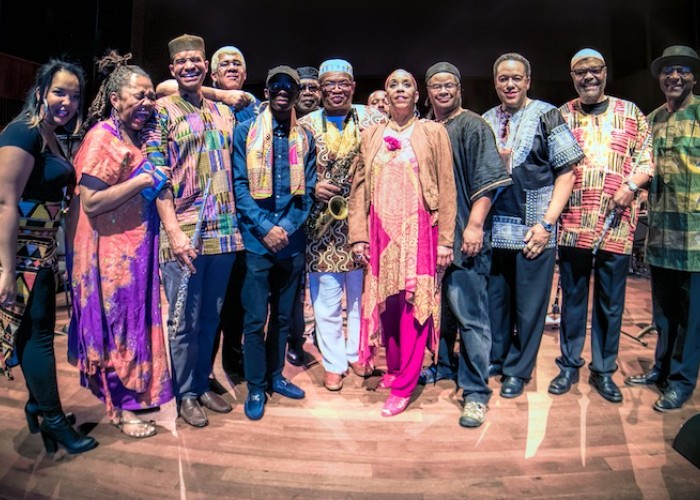Oct 28, 2025 10:47 AM
In Memoriam: Jack DeJohnette, 1942–2025
Jack DeJohnette, a bold and resourceful drummer and NEA Jazz Master who forged a unique vocabulary on the kit over his…

The AACM Great Black Music Ensemble is Alexis Lombre (left), Dee Alexander, Adam Zaonilni, Steve Berry, Frank Morrison, Ed House, Ernest Dawkins, Ben Lamar Gay, Maggie Brown, Darius Savage, Art Turk Burton, Taalib-Din Ziyad and Donovan Mixon.
(Photo: Michael Jackson)Chicago’s Association for the Advancement of Creative Musicians has been an inspirational leader within the music and cultural community since 1965.
In the spirit of the organization’s mission to showcase original compositions, the latest live recording of its performing group, AACM Great Black Music Ensemble: Live At The Currency Exchange Vol. 1, is a wonder-filled sampler fulfilling the ensemble’s calling.
Led by saxophonist Ernest Khabeer Dawkins, the AACM Great Black Music Ensemble brings together 10 works from that live session of improvised music, rife with the musical essence of the entire African diaspora, including funk, blues, bebop, and Caribbean beats and grooves. Ten performers participated, including Saalik Ziyad, the recording now also functioning as a tribute to the keyboardist/vocalist, who suddenly passed away earlier this year at the age of 40. His father, flutist/vocalist Taalib-Din Ziyad, also performed on the album.
Downbeat recently spoke with Dawkins about the live recording, conduction and being an occasional autocrat on the bandstand.
The following has been edited for length and clarity.
Can you tell me about what led up to recording the live album?
Nothing, nothing was planned; it’s all improvisational creative music. It’s all spontaneous composing. Everything was conduction.
Where I first saw conduction done was with Muhal Richard Abrams, the AACM experimental band, in the ’70s. So, it’s just a matter of signals, gestures, shapes. It first was used by AACM musicians, and Butch Morris is the one that codified it.
Since it’s all happening spontaneously, how does each song get composed?
With that process, I’m listening. And as I listen, then I tell or I inform the musicians what my general intentions are. I might sing a line, I might do something. And then, in terms of [the song] “Great Black Music,” we started the theme, and then we started the riff: “Great ... Black ... Music ... .”
So, it’s like a combination of improvisations being simultaneously put together, or interpretations of things being put together. And then I might tell one person, “Harmonize the part.” Nothing is predetermined.
And the resulting pieces end up being quite different from each other, each a unique gem.
That’s the idea. Or the pieces have different aesthetic sensibilities. So, if you let everything gravitate into one thing, then everything starts sounding the same. So, that’s my job as the conductor. I’m listening to the music, and I’m hearing it a certain way ... . I want those people to interpret it a certain way. ... Once I feel that they’re stepping over into another possibility, I try to reserve that possibility for a whole different section. So, then you get a variant of every composition, and then every composition does not sound the same.
At a certain point, you feel that something has ended or the transition is complete?
When you listen, the music will tell you when it’s complete.
So, these pieces will never be repeated again.
That’s the whole point: We can replicate what we do. But we don’t want to.
And how similar is the process to conducting an orchestra?
It’s similar, but it’s different. Because you’re creating on the spot, right? You don’t have a set score when you’re doing these improvisational sets, right? So, it’s really the concept and the creativity, and the expanse of the creativity is really in the hands of the musicians and the conductor.
Do you sometimes have to rein people in?
If they’re out of [the context of] what we’re doing? Definitely, that’s the conductor’s job: When someone’s straying, I bring them back. But, sometimes when someone’s straying, and they stray within a certain context, I say, let’s follow them. I’m listening to what the musicians do.
The process, it seems, is very democratic, even though there’s a conductor. But how much freedom do the musicians have?
It’s democratic and it’s also autocratic. There are no boundaries as to what it is. We tend to think that one way is the way. And one way is not the way. Sometimes, you need an autocratic dictator. And then sometimes, you need a democratic person.

Jack DeJohnette boasted a musical resume that was as long as it was fearsome.
Oct 28, 2025 10:47 AM
Jack DeJohnette, a bold and resourceful drummer and NEA Jazz Master who forged a unique vocabulary on the kit over his…

Always a sharp dresser, Farnsworth wears a pocket square given to him by trumpeter Art Farmer. “You need to look good if you want to hang around me,” Farmer told him.
Sep 23, 2025 11:12 AM
When he was 12 years old, the hard-swinging veteran drummer Joe Farnsworth had a fateful encounter with his idol Max…

D’Angelo achieved commercial and critical success experimenting with a fusion of jazz, funk, soul, R&B and hip-hop.
Oct 14, 2025 1:47 PM
D’Angelo, a Grammy-winning R&B and neo-soul singer, guitarist and pianist who exerted a profound influence on 21st…

Kandace Springs channeled Shirley Horn’s deliberate phrasing and sublime self-accompaniment during her set at this year’s Pittsburgh International Jazz Festival.
Sep 30, 2025 12:28 PM
Janis Burley, the Pittsburgh International Jazz Festival’s founder and artistic director, did not, as might be…

Jim McNeely’s singular body of work had a profound and lasting influence on many of today’s top jazz composers in the U.S. and in Europe.
Oct 7, 2025 3:40 PM
Pianist Jim McNeely, one of the most distinguished large ensemble jazz composers of his generation, died Sept. 26 at…